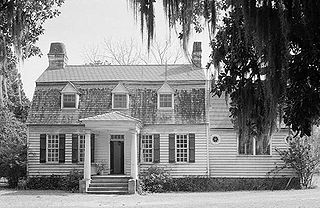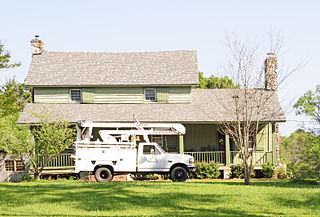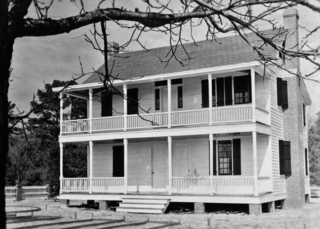
Richburg is a town in Chester County, South Carolina, United States. The population was 275 at the 2010 census, down from 332 at the 2000 census.

Stagville Plantation is located in Durham County, North Carolina. With buildings constructed from the late 18th century to the mid-19th century, Stagville was part of one of the largest plantation complexes in the American South. The entire complex was owned by the Bennehan, Mantack and Cameron families; it comprised roughly 30,000 acres (120 km2) and was home to almost 900 enslaved African Americans in 1860.

The Landsford Canal is a navigation channel that opened in 1823 with the purpose of bypassing rapids along the Catawba River to allow efficient freight transport and rapid travel between nearby communities and settlements along the rural frontiers of the era. It had five locks operating over a stretch of two miles (3.2 km) with an elevation change overall of 32–34 feet (9.8–10.4 m). It was part of the inland navigation system from the 'Up Country' to Charleston, built systematically from 1819, and the navigations are today the centerpiece of Canal State Park:
The Canal State Park consists of three sets of locks, a mill site, miller's house, and a lockkeeper's house—all in various forms of decay and ruins.

The Oakland Plantation House which is also known as Youghall or Youghal Plantation House, was built about 1750 in Charleston County, South Carolina about 7 mi (11 km) east of Mount Pleasant. It is located about 1 mile (1.6 km) south of U.S. Route 17 on Stratton Place. It was named to the National Register of Historic Places on July 13, 1977.
Pine Island Plantation Complex is a historic hunting plantation complex and national historic district located on Pine Island near Frogmore, Beaufort County, South Carolina. The district encompasses six contributing buildings and one contributing sites, and is an early-20th century hunting plantation. The main house at Pine Island was built about 1904, and is a two-story frame structure built on an existing tabby foundation. The front façade features a full-width two-story porch. Also on the property are the contributing cottage, a toolshed/doghouse, a barn, a pumphouse, an automobile garage, and causeway.

Oakland Plantation, also known as the Wade Glover House, is a historic plantation home located near Beech Island, Aiken County, South Carolina. It was built in 1824–1826, and is a Carolina I-house with minimal mid-19th century and early-20th century additions and alterations. It has a central hall two-over-two floor plan with gable-end chimneys, one-story gallery on the facade, and shed room on the rear elevation. Also on the property are two contributing outbuildings: a frame one-story gable-end dairy house and a frame one-story gable-end garage.

Lewisfield Plantation is a historic plantation house located near Moncks Corner, Berkeley County, South Carolina. It was built about 1774, and is a 2 1/2-half story clapboard dwelling. It is supported by a high brick foundation that encloses a raised basement. It has a five bay wide verandah supported by six slender Doric order columns. Records show over 100 slaves were held in bondage on the plantation as of 1835.
Richmond Plantation, also known as Girl Scout Plantation, is a national historic district located near Cordesville, Berkeley County, South Carolina. It was built about 1927, and includes a manor house and outbuildings constructed as a hunting lodge for George A. Ellis, a prominent New York financier and co-founder of E. F. Hutton & Co.

Zante Plantation was a historic plantation house located near Fort Motte, Calhoun County, South Carolina. It was built about 1815, and is a 2+1⁄2-story frame structure with Federal details. It has a stucco-over-brick foundation approximately 7 feet (2.1 m) high. Both front and rear facades have one-story porches. Several original outbuildings remain on the property. Zante has been the home of several prominent South Carolinians, its history reaching as far back as the late-18th century.

Nuckolls-Jefferies House, also known as the Nuckolls House and Wagstop Plantation, is a historic plantation house located near Pacolet, Cherokee County, South Carolina. It was built in 1843, with alterations in the 1870s or 1880s. It is a 2+1⁄2-story, frame residence in a combined Greek Revival / Classical Revival style. It is clad in weatherboard and sits on a stone foundation. The front facade features a two-tiered central, pedimented portico supported by two sets of slender wooden posts. The rear of the house has a two-story ell, built during the 1996 restoration. Also on the property are three contributing outbuildings: a small, one-story log gable-front building that dates from the mid-to-late 19th century that served as the farm's smokehouse, a 1+1⁄2-story gable-front frame barn, and another frame gable-front barn with side shed lean-to extensions.

Chester City Hall and Opera House is a historic city hall and theatre located at Chester, Chester County, South Carolina. It was built in 1890–1891, and is a Romanesque Revival style brick building. The façade consists of three sections: a four-story tower, gabled three-story central section, and a less ornate three-story section. The interior was renovated following a fire in 1929, which destroyed the original spire tower containing a four-faced clock. Since 1891, this building has housed the town's administrative offices.

Lewis Inn is a historic inn near Chester, Chester County, South Carolina, United States. It was built about 1750 and is a "matched" two-story log house covered with clapboard. It was re-covered with brown shingles in 1923. It has a lateral gable roof, with exterior end chimneys, and a one-story right wing. The inn was a tavern during Colonial and Revolutionary days and also a stagecoach stop. In 1807, Aaron Burr spent the night there on his way to Richmond for trial on charges of treason. Legend has it that Burr escaped briefly because a bribed maid left his bedroom door unlatched.

Colvin–Fant–Durham Farm Complex, also known as the Nicholas Colvin House and Durham House, is a historic home and farm complex and national historic district located near Chester, Chester County, South Carolina. The district encompasses six contributing buildings. The house was built about 1835, and is a vernacular farmhouse with transitional Federal and early Greek Revival detailing. The house consists of a two-story, hall and parlor plan, frame main block and a one-story, frame dining room and kitchen ell, which was added in the late-19th century. The property also includes a smokehouse, well house/power house, mule barn, tenant house, and a log cottonseed house.
Elliott House, also known as Chester County Log Cabin, is a historic home located near Richburg, Chester County, South Carolina. It was built about 1770, and is a two-story, late 18th to early 19th century log dwelling. The house features a tall shed-roofed porch across the front, a steeply pitched gable roof, an end chimney, stone piers, and dovetailed log joints. The interior floors and ceilings are original heart pine.
Dove Dale, also known as the Archibald Dove House, Daniel Dove House, and Grover Bryant House, is a historic plantation house near Darlington, Darlington County, South Carolina. The original section dates to about 1805, with later 19th- and early 20th-century alterations. It is a 1½-story frame double-pile, spraddle-roofed house. The house features a front porch with six wood piers. A contributing small fish pond is an early landscape feature of the front lawn. Surrounding the house are agricultural fields that have continued under cultivation for over 200 years.

Arcadia Plantation, originally known as Prospect Hill Plantation, is a historic plantation house located near Georgetown, Georgetown County, South Carolina. The main portion of the house was built about 1794, as a two-story clapboard structure set upon a raised brick basement in the late-Georgian style. In 1906 Captain Isaac Edward Emerson, the "Bromo-Seltzer King" from Baltimore, purchased the property. Two flanking wings were added in the early 20th century. A series of terraced gardens extend from the front of the house toward the Waccamaw River. Also on the property is a large two-story guest house, tennis courts, a bowling alley, stables, five tenant houses and a frame church. The property also contains two cemeteries and other plantation-related outbuildings.

Donald Bruce House, also known as Middlepen Plantation, is a historic plantation home located near Orangeburg, Orangeburg County, South Carolina. It was originally built during the 18th century in downtown Orangeburg and was moved to Middlepen Plantation about 1837. The house is a two-story frame structure with a two-tiered front piazza. It was used as headquarters during the American Revolution at different times by both Governor John Rutledge and by the British commander, Lord Francis Rawdon.
Laurelwood is a historic plantation house located in rural Richland County, South Carolina, near the city of Eastover. It was built about 1830, and is a two-story frame dwelling with a central-hall, double-pile plan. The front façade features a two-tier, three bay, pedimented portico in the Greek Revival style. It has a one-story, frame addition built in the early-20th century. Also on the property are the contributing frame smokehouse and a frame barn. Also notable is the survival of a slave quarters.

Ashley Hall Plantation is a historic plantation complex located on the Ashley River near West Ashley, Charleston County, South Carolina. The plantation was established in the early 1670s by Stephen Bull. The property includes a small tabby-walled house with a 20th-century second story addition, the ruins of the Georgian plantation house (1704) which was burned in 1865 to prevent its destruction by Union forces, a monument to the second Governor William Bull, two prehistoric Indian archaeological sites, and two 18th century well sites associated with the plantation. The tabby house is considered one of the oldest standing houses in the state.
Towles Farmstead, also known as Goshen Plantation and Plainsfield, is a historic farmstead and national historic district located near Meggett, Charleston County, South Carolina. The district encompasses 11 contributing buildings, 2 contributing sites, and 1 contributing structure. They include two early-20th century residences: a one-story, frame house constructed about 1903, with characteristic Neo-Classical and Bungalow features; and a two-story, rectangular frame house constructed in 1930, with characteristic Colonial Revival and Italian Renaissance features. Associated with the houses are a variety of contributing utility outbuildings.

















